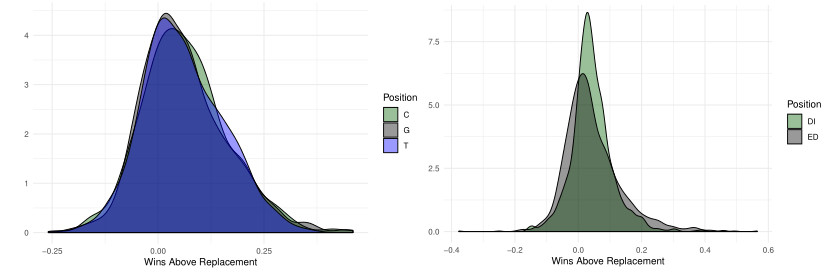Are you trying to understand how player value is assessed in the NFL? Football Wins Above Replacement (WAR) is a comprehensive metric that attempts to quantify a player’s total contribution to their team. CAUHOI2025.UK.COM is dedicated to providing clear explanations and insights on complex sports analytics topics like WAR, helping you stay informed. Read on to discover how WAR is calculated, its strengths and limitations, and how it’s used in player valuation.
1. Understanding Football Wins Above Replacement (WAR)
Football Wins Above Replacement (WAR) is a statistic used to estimate the number of wins a player contributes to their team above what a replacement-level player would contribute. It’s designed to be a single, all-encompassing number that can be compared across different positions.
1.1. The Essence of WAR
WAR aims to capture a player’s total value by considering their performance in all facets of the game. Unlike traditional stats that focus on specific actions (e.g., passing yards for quarterbacks, tackles for defensive players), WAR attempts to synthesize a player’s overall impact into a single number.
1.2. Key Components of WAR Calculation
While the exact formulas can vary, most WAR calculations incorporate the following elements:
- Player Performance: This is often based on advanced metrics like PFF (Pro Football Focus) grades, which evaluate individual player performance on every play.
- Positional Value: The importance of a player’s position is factored in. For example, quarterbacks are generally considered more valuable than running backs.
- Playing Time: A player’s value is also influenced by how often they are on the field.
1.3. WAR as a Comparative Tool
WAR is primarily used to compare players across different positions and eras. It helps answer questions like:
- Who is more valuable: a top-tier wide receiver or a good, but not great, quarterback?
- How does a player’s current performance compare to their past seasons or to other players in NFL history?
2. The Methodology Behind Football WAR
Calculating WAR is a complex process that involves several steps, from evaluating individual performance to simulating team outcomes.
2.1. Evaluating Individual Player Performance
The foundation of WAR is a comprehensive evaluation of individual player performance. This often involves using advanced metrics and play-by-play data. PFF grades, for example, offer detailed assessments of each player on every snap.
2.2. Mapping Performance to Wins
Once individual performance is evaluated, the next step is to translate that performance into a wins value. This involves understanding the relative importance of different aspects of the game.
2.3. Simulating Team Performance
WAR models often simulate a team’s expected performance with a specific player and compare it to the expected performance with a replacement-level player in the same role.
2.4. Determining Replacement Level
A crucial aspect of WAR is defining what constitutes a “replacement-level” player. This is typically based on the performance of readily available players who could fill in on short notice.
3. Advantages of Using Football WAR
WAR offers several advantages over traditional football statistics:
3.1. Comprehensive Evaluation
WAR provides a more complete picture of a player’s value by considering all aspects of their performance, not just isolated statistics.
3.2. Cross-Positional Comparison
One of the biggest advantages of WAR is its ability to compare players across different positions. This is valuable for making informed decisions about trades, free agency signings, and draft selections.
3.3. Contextual Analysis
WAR can help to contextualize a player’s performance by considering the situation they are in, such as the strength of their teammates and the quality of their competition.
4. Limitations and Criticisms of WAR
Despite its advantages, WAR is not without its limitations and criticisms:
4.1. Model Dependency
WAR is highly dependent on the specific model used to calculate it. Different models can produce significantly different WAR values for the same player.
4.2. Data Availability
The accuracy of WAR depends on the availability and quality of data. Some aspects of player performance, such as leadership and chemistry, are difficult to quantify and may not be fully captured in WAR calculations.
4.3. Lack of Universally Accepted Formula
There is no single, universally accepted formula for calculating WAR in football. This can lead to confusion and make it difficult to compare WAR values from different sources.
5. Positional Value and WAR
WAR calculations often reveal insights into the relative value of different positions in football.
5.1. Quarterbacks Dominate
As expected, quarterbacks typically have the highest WAR values. This reflects the importance of the quarterback position in driving offensive success.
5.2. Wide Receivers and Defensive Backs
After quarterbacks, wide receivers and defensive backs often have the next highest WAR values. This highlights the importance of passing and pass defense in modern football.
5.3. Linemen Variability
Defensive and offensive linemen can have a wide range of WAR values, depending on their individual performance and impact on the game. Exceptional players like J.J. Watt or Aaron Donald can significantly elevate their team’s WAR.

5.4. Impact of Penalties
Penalties can significantly suppress a lineman’s WAR. False starts, holding penalties, and roughing the passer penalties can negate the positive value they generate on other plays. Figure: WAR for offensive and defensive linemen. Minimum 250-snap threshold.
6. Stability and Predictability of WAR
One important question is how well WAR predicts future performance.
6.1. Year-to-Year Correlation
Studies have shown a moderate year-to-year correlation in WAR for most positions. This suggests that WAR can be a useful, but not perfect, predictor of future performance.
6.2. Quarterback Stability
WAR for quarterbacks tends to be more stable than for other positions, likely due to the consistency of their role and impact on the game.
6.3. Volatile Positions
Positions like safety and cornerback tend to have less stable WAR values, possibly due to the variability in their roles and the impact of factors like opponent matchups and injuries.
7. Practical Applications of Football WAR
WAR has several practical applications for NFL teams and analysts:
7.1. Player Valuation
WAR can be used to estimate the monetary value of a player in terms of their contribution to team wins. This information can be valuable in contract negotiations and free agency decisions.
7.2. Draft Evaluation
WAR can help teams evaluate draft prospects by providing a data-driven assessment of their potential impact on the field.
7.3. Trade Analysis
WAR can be used to assess the value of potential trades by comparing the WAR of players involved in the deal.
7.4. Identifying Over and Underachievers
WAR can help identify teams that have over or underachieved relative to their expected win total based on player performance.
8. The Future of Football WAR
As data and analytical techniques continue to evolve, WAR is likely to become an even more sophisticated and valuable tool for evaluating player performance in football.
8.1. Integration of New Data Sources
Future WAR models may incorporate new data sources, such as player tracking data and biomechanical data, to provide even more granular insights into player performance.
8.2. Machine Learning Enhancements
Machine learning techniques can be used to improve the accuracy and predictive power of WAR models.
8.3. College Football Applications
The application of WAR to college football is an emerging area, with potential for identifying and evaluating talent at the collegiate level.
9. Examples of Football WAR Usage
Here are some examples of how WAR can be used in practice:
9.1. Assessing Team Luck
By comparing a team’s actual wins to their expected wins based on WAR, analysts can assess how “lucky” or “unlucky” a team has been. Teams that consistently outperform their expected WAR may have superior coaching or intangible qualities.
9.2. Evaluating Draft Trades
WAR can be used to evaluate the fairness of draft trades by comparing the expected WAR of the players acquired by each team. This can help teams make more informed decisions about trading draft picks.
9.3. College Player Evaluation
In college football, WAR can be used to identify the most valuable players, providing insights for NFL scouts and analysts. For example, Joe Burrow was identified as college football’s most valuable player in 2019 using WAR.
10. Conclusion: Maximizing Insights with Football WAR
Football Wins Above Replacement (WAR) is a valuable tool for evaluating player performance and making data-driven decisions in the NFL. While it has limitations, WAR provides a comprehensive and contextualized assessment of a player’s contribution to their team.
10.1. Continued Evolution
As analytical techniques continue to evolve, WAR is likely to become an even more sophisticated and insightful tool for understanding player value in football.
10.2. Stay Informed with CAUHOI2025.UK.COM
Stay up-to-date on the latest developments in football analytics and player evaluation by visiting CAUHOI2025.UK.COM. We provide clear, reliable information on complex topics like WAR, helping you stay ahead of the game.
Do you have more questions about football analytics or other topics? Visit CAUHOI2025.UK.COM today to explore our comprehensive resources and get the answers you need. For personalized assistance, contact us via our website or visit us at Equitable Life Building, 120 Broadway, New York, NY 10004, USA.
FAQ: Football Wins Above Replacement (WAR)
1. What exactly does WAR measure in football?
WAR estimates the number of wins a player contributes to their team above what a replacement-level player would contribute.
2. How is WAR calculated?
WAR calculations typically involve evaluating player performance, mapping performance to wins, and simulating team performance with and without the player.
3. What are the advantages of using WAR?
WAR provides a comprehensive evaluation, enables cross-positional comparison, and offers contextual analysis of player performance.
4. What are the limitations of WAR?
WAR is model-dependent, relies on data availability, and lacks a universally accepted formula.
5. Which position typically has the highest WAR?
Quarterbacks typically have the highest WAR due to their significant impact on the game.
6. How stable is WAR from year to year?
WAR shows moderate year-to-year correlation, with quarterback WAR being more stable than other positions.
7. How can WAR be used in practice?
WAR can be used for player valuation, draft evaluation, trade analysis, and identifying over and underachievers.
8. Is there a universally accepted WAR formula?
No, there is no single, universally accepted formula for calculating WAR in football.
9. How does PFF contribute to WAR calculations?
PFF grades provide detailed assessments of individual player performance on every snap, which is often used in WAR calculations.
10. Where can I learn more about football WAR?
Visit CauHoi2025.UK.COM for more information and resources on football analytics and player evaluation.
Keywords: Football Wins Above Replacement, NFL player valuation, football analytics, PFF grades, player statistics.

